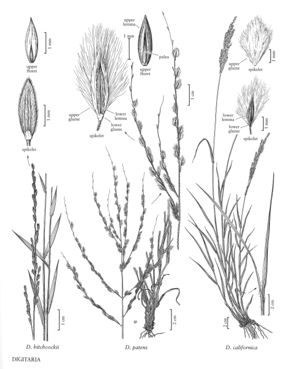Difference between revisions of "Digitaria californica"
FNA>Volume Importer |
FNA>Volume Importer |
||
| Line 6: | Line 6: | ||
|synonyms={{Treatment/ID/Synonym | |synonyms={{Treatment/ID/Synonym | ||
|name=Trichachne californica | |name=Trichachne californica | ||
| − | |authority= | + | |authority= |
| + | |rank=species | ||
}} | }} | ||
|hierarchy=Poaceae;Poaceae subfam. Panicoideae;Poaceae tribe Paniceae;Digitaria;Digitaria californica | |hierarchy=Poaceae;Poaceae subfam. Panicoideae;Poaceae tribe Paniceae;Digitaria;Digitaria californica | ||
| Line 19: | Line 20: | ||
-->{{Treatment/Body | -->{{Treatment/Body | ||
|distribution=Okla.;N.Mex.;Tex.;Calif.;Colo.;Ariz. | |distribution=Okla.;N.Mex.;Tex.;Calif.;Colo.;Ariz. | ||
| − | |discussion=<p>Digitaria californica grows on plains and open ground from Arizona, southern Colorado, and Oklahoma through Mexico and Central America to South America. The name reflects the fact that the first collection was made in Baja California, Mexico. Plants in the Flora region belong to D. californica (Benth.) Henrard var. californica. They differ from those of D. californica var. villosissima Henrard in having densely villous, rather than densely tomentose, leaves.</p> | + | |discussion=<p><i>Digitaria californica</i> grows on plains and open ground from Arizona, southern Colorado, and Oklahoma through Mexico and Central America to South America. The name reflects the fact that the first collection was made in Baja California, Mexico. Plants in the Flora region belong to <i>D. californica</i> (Benth.) Henrard <i></i>var.<i> californica</i>. They differ from those of <i>D. californica</i> <i></i>var.<i> villosissima</i> Henrard in having densely villous, rather than densely tomentose, leaves.</p> |
|tables= | |tables= | ||
|references= | |references= | ||
| Line 28: | Line 29: | ||
-->{{#Taxon: | -->{{#Taxon: | ||
name=Digitaria californica | name=Digitaria californica | ||
| − | |||
|authority=(Benth.) Henrard | |authority=(Benth.) Henrard | ||
|rank=species | |rank=species | ||
| Line 35: | Line 35: | ||
|basionyms= | |basionyms= | ||
|family=Poaceae | |family=Poaceae | ||
| − | |illustrator=Linda A. Vorobik | + | |illustrator=Linda A. Vorobik;Hana Pazdírková |
| + | |illustration copyright=Utah State University | ||
|distribution=Okla.;N.Mex.;Tex.;Calif.;Colo.;Ariz. | |distribution=Okla.;N.Mex.;Tex.;Calif.;Colo.;Ariz. | ||
|reference=None | |reference=None | ||
| Line 41: | Line 42: | ||
|publication year= | |publication year= | ||
|special status= | |special status= | ||
| − | |source xml=https:// | + | |source xml=https://jpend@bitbucket.org/aafc-mbb/fna-data-curation.git/src/f50eec43f223ca0e34566be0b046453a0960e173/coarse_grained_fna_xml/V25/V25_1066.xml |
|subfamily=Poaceae subfam. Panicoideae | |subfamily=Poaceae subfam. Panicoideae | ||
|tribe=Poaceae tribe Paniceae | |tribe=Poaceae tribe Paniceae | ||
Revision as of 20:30, 16 December 2019
Plants perennial; cespitose, neither rhizomatous nor stoloniferous. Culms 40-100 cm, erect, sometimes geniculate, not rooting, at the lower nodes. Basal sheaths villous; upper sheaths glabrous, densely villous or densely tomentose, or sparsely to densely hairy, with papillose-based hairs; ligules (1)1.5-6 mm, entire or lacerate, not ciliate; blades 2-12(18) cm long, 2-5(7) mm wide, glabrous or the adaxial surfaces sparsely to densely villous or tomentose. Panicles with 4-10 spike¬like primary branches on 5-10 cm rachises, rarely with secondary branches; primary branches 3-6 cm, appressed to ascending, axes not wing-margined; internodes 2-5.5 mm (midbranch), bearing spikelets in unequally pedicellate pairs; secondary branches rarely present; pedicels not adnate to the branch axes; shorter pedicels 0.1-0.3 mm; longer pedicels 1-2 mm; terminal pedicels of branches 1.7-6(7) mm. Spikelets homomorphic, (3.7)4-7.5 mm (including pubescence), 3-5.4 mm (excluding pubescence). Lower glumes 0.4-0.6 mm; upper glumes 2.5-5.1 mm (excluding pubescence), narrower than the upper florets, 3-veined, densely villous, hairs 1.5-5 mm, silvery-white to purple, widely divergent at maturity; lower lemmas 2.7-5 mm (excluding pubescence), pubescence exceeding the upper florets by 2.2-4 mm, 7-veined, veins unequally spaced, only the 3 or 5 central veins visible, margins and outer lateral veins densely pubescent, hairs 1.5-5 mm, silvery-white to purple, widely divergent at maturity, intercostal regions glabrous, apices attenuate (acuminate); upper lemmas 2.5-3.4 mm, ovate-lanceolate, brown to dark brown, acuminate. Caryopses 1.3-2 mm. 2n = 36, 54, 70, 72.
Distribution
Okla., N.Mex., Tex., Calif., Colo., Ariz.
Discussion
Digitaria californica grows on plains and open ground from Arizona, southern Colorado, and Oklahoma through Mexico and Central America to South America. The name reflects the fact that the first collection was made in Baja California, Mexico. Plants in the Flora region belong to D. californica (Benth.) Henrard var. californica. They differ from those of D. californica var. villosissima Henrard in having densely villous, rather than densely tomentose, leaves.
Selected References
None.
